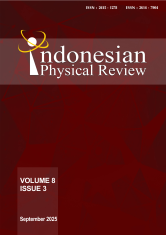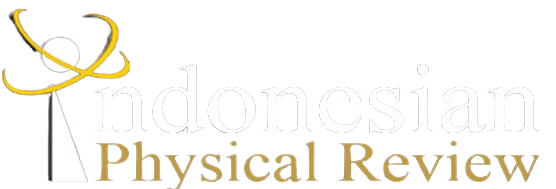INTEGRATING HIGH-RESOLUTION GRAVITY GRADIENTS AND 3D INVERSION MODELING TO DELINEATE MINERAL RESOURCES IN THE LEWA DISTRICT, EAST SUMBA, INDONESIA
DOI:
10.29303/ipr.v8i3.501Downloads
Abstract
Research in Lewa District, East Sumba Regency, Indonesia, aimed to identify mineral potential and clarify subsurface geological structures through gravity gradient analysis and 3D inversion modeling. This approach addresses the limitations of field gravity data in the study area. The gravity gradient method was chosen to delineate geological structure boundaries (such as formation contacts and faults) compared to conventional gravity methods and for processing global satellite data (GGMplus and EGM2008 derivatives of ERTM 2160) with limited measured data. Gravity gradient analysis, including vertical, horizontal gradient, and tilt angle, was applied to Complete Bouguer Anomaly data using 2D Fourier transformation. Gravity field correction in Lewa showed positive anomalies from volcanic basement rocks. The gradient analysis sharpened boundaries of anomalies linked to geological structures. Zero contours of vertical gradient and tilt angle defined structural boundaries, while peaks of horizontal gradient and tilt angle indicated metallic mineral sources. 3D gravity inversion modeling (density 2.22–2.97 g/cm³) showed rock intrusions at 215 meters depth, interpreted as key to mineralization formation. The 2D sections (A-A', B-B', C-C') contain Masu Formation volcanic rocks, with fault zones filled by Waikabubak Formation sedimentary rocks and silicified rocks from magma intrusion alteration. Fault systems were identified through vertical gradient extremes, representing contact formation. Highly positive contour values on the tilt angle map confirm the influence of the volcanic basement rock. Metal mineralization is closely related to tectonic activity and alteration from massive igneous intrusion. The integration of gravity gradient analysis and 3D inversion modeling has proven to be effective in mapping geological structures and identifying mineral prospects using limited data. These findings provide insights into the subsurface geology of Lewa and provide a basis for further mineral exploration in East Sumba.Keywords:
Mineral resources GGMplus ERTM 2160 vertical and horizontal gradient tilt angle gravity modelingReferences
Zulfikar, T., T. Sutisna, dan M. Supardan. Inventarisasi dan Evaluasi Mineral Non Logam di Kabupaten Sumba Barat dan Sumba Timur, Provinsi Nusa Tenggara Timur. Bandung: Direktorat Sumber Daya Mineral, 2004. https://geologi.esdm.go.id/perpustakaan?p=show_detail&id=6892.
Tim Prospeksi. Laporan Prospeksi Mineral Logam di Kabupaten Sumba Timur, Provinsi Nusa Tenggara Timur. Bandung: Kementerian Energi dan Sumber Daya Mineral, 2011. https://geologi.esdm.go.id/perpustakaan?p=show_detail&id=2583.
J. Yan, Q. Lu, F. Luo, S. Cheng, K. Zhang, Y. Zhang, Y. Xu, C. Zhang, Z. Liu, S. Ruan, X. Wang, “A gravity and magnetic study of lithospheric architecture and structures of South China with implications for the distribution of plutons and mineral systems of the main metallogenic belts,†J. Asian Earth Sci., vol. 221, p. 104938, Nov. 2021.
M. O. zgu Arısoy and Ü. Dikmen, “Potensoft: MATLAB-based software for potential field data processing, modeling and mapping,†Comput. Geosci., vol. 37, no. 7, pp. 935–942, Jul. 2011.
A. Eshaghzadeh, A. Dehghanpour, and R. A. Kalantari, “Application of the tilt angle of the balanced total horizontal derivative filter for the interpretation of potential field data,†BGTA, vol. 59, no. 2, pp. 161–178, 2018.
C. Hirt, S. Claessens, T. Fecher, M. Kuhn, R. Pail, and M. Rexer, “New ultrahigh-resolution picture of Earth’s gravity field: NEW PICTURE OF EARTH’S GRAVITY FIELD,†Geophys. Res. Lett., vol. 40, no. 16, pp. 4279–4283, Aug. 2013.
C. Hirt, M. Kuhn, S. Claessens, R. Pail, K. Seitz, and T. Gruber, “Study of the Earth׳s short-scale gravity field using the ERTM 2160 gravity model,†Comput. Geosci., vol. 73, pp. 71–80, Dec. 2014.
Y. L. Ekinci and E. Yiğitbaş, “Interpretation of gravity anomalies to delineate some structural features of Biga and Gelibolu peninsulas, and their surroundings (north-west Turkey),†Geodin. Acta, vol. 27, no. 4, pp. 300–319, Oct. 2015.
P. Sumintadireja, D. Dahrin, and H. Grandis, “A Note on the Use of the Second Vertical Derivative (SVD) of Gravity Data with Reference to Indonesian Cases,†vol. 50, no. 1, pp. 127–139, 2018.
G. De Gelder, T. Solihuddin, D. Amanda Utami, M. Hendrizan, R. Rachmayani, D, Chauveau, C. Authemayou, L. Husson, S. Yudawati Cahyarini, “Geodynamic control on Pleistocene coral reef development: Insights from northwest Sumba Island (Indonesia),†Earth Surf. Process. Landf., vol. 48, no. 13, pp. 2536–2553, Oct. 2023.
M. C. Dentith and S. T. Mudge, Geophysics for the mineral exploration geoscientist. Cambridge, United Kingdom: Cambridge University Press, 2014.
E. Balkan and M. Tün, “Use of Land Gravity Data in Small Areas to Support Structural Geology, a Case Study in Eskişehir Basin, Turkey,†Appl. Sci., vol. 13, no. 4, p. 2286, Feb. 2023.
R. Lewerissa, Sismanto, and L. A. S. Lapono, “Identification of sediment–basement structure in West Papua province, Indonesia, using gravity and magnetic data inversion as an Earth’s crust stress indicator,†Acta Geophys., vol. 71, no. 1, pp. 209–226, Sep. 2022.
I. M. Ibraheem, M. Haggag, and B. Tezkan, “Edge Detectors as Structural Imaging Tools Using Aeromagnetic Data: A Case Study of Sohag Area, Egypt,†Geosciences, vol. 9, no. 5, p. 211, May 2019.
M. Hicheri, B. Ramdhane, S. Yahyaoui, and T. Gonenc, “New Insights from Gravity Data on the Geodynamic Evolution of Northern African Passive Margin, Case Study of the Tajerouine Area (Northern Tunisian Atlas),†J. Geol. Geophys., vol. 08, no. 01, 2018.
J. Abderbi, D. Khattach, and J. Kenafi, "Multiscale analysis of the geophysical lineaments of the High Plateaus (Eastern Morocco): structural implications," J. Mater. Environ. Sci., vol. 8, pp. 467–475, 2017.
R. Lewerissa, S. Sismanto, A. Setiawan, and S. Pramumijoyo, “The igneous rock intrusion beneath Ambon and Seram islands, eastern Indonesia, based on the integration of gravity and magnetic inversion: its implications for geothermal energy resources,†Turk. J. EARTH Sci., vol. 49, no. 4, pp. 596–616, May 2020.
L. T. Pham, K. Abdelrahman, Da. Viet Nguyen, D Gomez-Ortiz, N. Ngoc Long, L. Duc Luu, T. Duc Do, Q. Thanh Vo, T. Thi Nguyen, H. Thi Nguyen, A. Eldosouky, “Enhancement of the balanced total horizontal derivative of gravity data using the power law approach,†Geocarto International, vol. 39, no. 1, p. 2335251, Jan. 2024.
J. Nouraliee, S. Porkhial, M. Mohammadzadeh-Moghaddam, S. Mirzaei, D. Ebrahimi, and M. R. Rahmani, “Investigation of density contrasts and geologic structures of hot springs in the Markazi Province of Iran using the gravity method,†Russ. Geol. Geophys., vol. 56, no. 12, pp. 1791–1800, Dec. 2015.
M. Mohammadzadeh Moghaddam, S. Mirzaei, J. Nouraliee, and S. Porkhial, “Integrated magnetic and gravity surveys for geothermal exploration in Central Iran,†Arab. J. Geosci., vol. 9, no. 7, p. 506, Jun. 2016.
Z. Chen, L. Mou, and X. Meng, “The horizontal boundary and top depth estimates of buried source using gravity data and their applications,†J. Appl. Geophys., vol. 124, pp. 62–72, Jan. 2016.
K. L. Mickus and J. H. Hinojosa, “The complete gravity gradient tensor derived from the vertical component of gravity: a Fourier transform technique,†J. Appl. Geophys., vol. 46, no. 3, pp. 159–174, Mar. 2001.
H. Grandis and D. Dahrin, “Full Tensor Gradient of Simulated Gravity Data for Prospect Scale Delineation,†vol. 46, no. 2, pp. 107–124, 2014.
M. Pirttijarvi, FOURPOT: Potential field data processing and analysis using 2-D Fourier transform, User's guide to version 1.3b, Department of Physics, University of Oulu, Finland, 2014. https://sites.google.com/view/markkussoftware/gravity-and-magnetic-software/fourpot.
M. Abdel Zaher, H. Saibi, K. Mansour, A. Khalil, and M. Soliman, “Geothermal exploration using airborne gravity and magnetic data at Siwa Oasis, Western Desert, Egypt,†Renew. Sustain. Energy Rev., vol. 82, pp. 3824–3832, Feb. 2018.
H. Saibi, S. Mogren, M. Mukhopadhyay, and E. Ibrahim, “Subsurface imaging of the Harrat Lunayyir 2007–2009 earthquake swarm zone, western Saudi Arabia, using potential field methods,†J. Asian Earth Sci., vol. 169, pp. 79–92, Jan. 2019.
S. B. Babu, A. V. Satyakumar, A. V. Kulkarni, and P. K. Vats, “Structurally controlled mineralization in parts of Aravalli craton, India: Constraints from gravity and magnetic data,†J. Geodyn., vol. 155, p. 101954, Mar. 2023.
S. A. Hosseini, N. Keshavarz Faraj Khah, P. Kianoush, Y. Arjmand, A. Ebrahimabadi, and E. Jamshidi, “Tilt angle filter effect on noise cancelation and structural edges detection in hydrocarbon sources in a gravitational potential field,†Results in Geophysical Sciences, vol. 14, p. 100061, Jun. 2023.
License

This work is licensed under a Creative Commons Attribution-NonCommercial-ShareAlike 4.0 International License.
Authors who publish with Indonesian Physical Review Journal, agree to the following terms:
- Authors retain copyright and grant the journal right of first publication with the work simultaneously licensed under a Creative Commons Attribution-ShareAlike 4.0 International Licence (CC BY SA-4.0). This license allows authors to use all articles, data sets, graphics, and appendices in data mining applications, search engines, web sites, blogs, and other platforms by providing an appropriate reference. The journal allows the author(s) to hold the copyright without restrictions and will retain publishing rights without restrictions.
- Authors are able to enter into separate, additional contractual arrangements for the non-exclusive distribution of the journal's published version of the work (e.g., post it to an institutional repository or publish it in a book), with an acknowledgment of its initial publication in Indonesian Physical Review Journal.
- Authors are permitted and encouraged to post their work online (e.g., in institutional repositories or on their website) prior to and during the submission process, as it can lead to productive exchanges, as well as earlier and greater citation of published work (See The Effect of Open Access).





